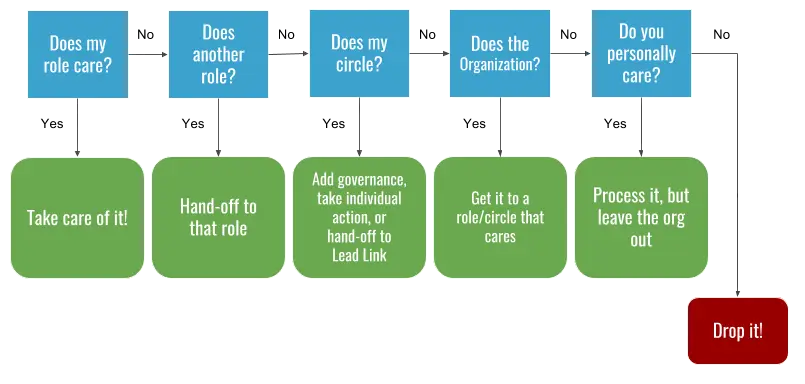
In self-organized companies, more people will make more decisions of more consequence. This means the number of decisions needed within the organization could easily outpace their quality.
And I’m talking here about deliberative decisions, not intuitive decisions. Meaning, I’m not talking about immediate or reactive decisions (e.g. how to respond to a reporter’s question, or should you turn left or right at the next intersection), but about deliberative decision-making. Decisions about which you have some time to thoughtfully weigh options or alternatives before acting.
Now, the old management hierarchy seems perfectly designed to buffer individuals against the impact of their decisions (It’s only those at the top who have nowhere to hide, which is why we pay them the big bucks). But when we consciously distribute authority to everyone, everyone needs to become a better decision-maker.
How do you get better? Well, as the saying goes, good judgment tends to come from experience, and experience tends to come from bad judgment. But usually, experience alone isn’t sufficient. You need to understand your experience to fully metabolize it.
To that end, I’ve collected a few decision-making heuristics, which might help you navigate your experience more elegantly.
“What would trigger a need to revisit this decision?”
Chip & Dan Heath’s book, Decisive, describes the following story, which I’m shortening quite a bit:
In 1981, Kodak, the largest photographic film company at the time, evaluated the potential impact of the emerging digital photography market on their business. They concluded,
- The quality of prints from electronic images will not be generally acceptable to consumers as a replacement to film.
- The consumer’s desire to display and distribute prints cannot be replaced by digital devices.
- Electronic systems will not be low enough in price to have widespread appeal.
After completely misjudging the digital market, in January 2012 Kodak filed for bankruptcy. What happened? Well, the analysis they made in 1981 was completely accurate through the 80s and even the 90s. Their careful analysis gave them no cause for concern, but because day-to-day change is gradual, they never set themselves a trigger to re-evaluate their involvement in the digital market. They were on autopilot.
What if instead, after concluding their analysis, they established some triggers. So, “The consumer’s desire to display and distribute prints cannot be replaced by digital devices,” tells us to establish a trigger like, “We will act when some kind of electronic viewing system is acquired by more than 5% of the public.”
The point is to establish an early-warning alert system. And the way most of us handle unpredictable futures is to play a game called, “I’ll just wait and see.” The problem with that approach is we don’t actually know what we’re waiting for.
“Delay the decision until the last responsible moment.”
This means, don’t stress about a decision you can make later. Imagine you and I are planning a trip to Hawaii in 6 months and I ask if you want to go parasailing while we’re there. I think it will be fun. You’re not so sure. Well, I might now feel a little annoyed because you’re not as enthusiastic as I am, but the question I really need to be asking myself is, “Does this decision even need to be made right now…6 months in advance?” Probably not.
But maybe it does. How would I know the difference? Well, gather some data. Is there a huge discount for booking 6 months in advance? Nope. I call some vendors and all of them say they take same-day bookings. Does parasailing require some specific personal items we’d need to pack before we leave? Nope, again. So, really the whole decision about parasailing or no parasailing can be figured out on-the-fly when we get there. That’s an example of delaying the decision until the last responsible moment.
Not only does this generally make for better quality decisions, but it can save you from having arguments that never needed to happen in the first place. By avoiding a pre-mature decision, we’re less likely to become victims of our own psychology (e.g. sunk cost fallacy, etc.), which would otherwise make us more likely to stay committed to a course of action even when new evidence is trying to tell us it’s the wrong one.
“How reversible is this decision?”
This is particularly important for figuring out how much data you might need to gather before moving ahead. This is like asking, “How important is this?” or “How much impact will this have?” but both of those questions seem vague when compared to the precision of asking explicitly about a decision’s reversibility.
People who’ve attended the Holacracy Practitioner Training often find the question, “Is it safe enough to try?” stuck in their heads long after the training has completed. Why? Because it’s a great heuristic. It’s a question used to test objections during a Governance meeting, but its utility extends far beyond that specific context. Another version is, “Be a Ferrari,” which is memorable and roughly conveys the same message, but again I find those less useful than, “How reversible is this decision?” because “reversibility” is both novel and specific (i.e. it defines what “safe enough” really means).
So, if my wife and I are arguing over which picture to hang on the wall, then we’ve probably fallen into a trap. No matter which picture goes up right now, it can easily be changed. So, why argue about it? Hang up either one. See how it goes and adapt as needed.
This can also be helpful when you’re uncomfortable making a decision that will impact others by asking yourself, “How much input is this decision worth?” If it’s creating a new business line, then sure, gather lots of input. But if it something that can easily be changed tomorrow, then probably not worth getting any input upfront. Just go ahead.
“Do I need to care about this?”
There’s no point in making a decision that someone else should make. The trap is assuming that just because something has entered our world that it’s ours to deal with. Maybe the most appropriate response is to pass it along to someone else.
Just because I got an email from someone I met asking if HolacracyOne is hiring, doesn’t mean I need to handle it. With the clarity of roles, I can distinguish between a decision I need to make and a decision someone else should make without falling into the trap of assuming that if I don’t do something, no one will.
It’s easy to assume that if something has your attention it should have your attention. After all, the email was sent to you. The bright idea you had is yours. And generally, it’s true. Most work stuff you come across applies to one of your roles, but in today’s connected world you have visibility far beyond the limits of your roles, so be aware of what NOT to do.
And while no one wants to be seen as someone who doesn’t care, that isn’t the kind of care we’re talking about here. If a goalie cares about the team, she needs to not care about scoring. If she leaves the net and tries to score, she’s not doing her job well. She makes her team vulnerable and gets in the way of others. She’s not a good team player.
In order to focus on one thing, we have to not focus on others. So, just because you answer “no” to “Does my role care?” it doesn’t mean you drop it. It’s not about avoiding responsibility. It’s about figuring out where that work lives. It’s genuinely asking “Who cares about this?” so you can get it to the right place. Again, there’s no point in wrestling with a difficult decision that someone else should be making.
Join me on the Holacracy Community of Practice.
Read “Introducing the Holacracy Practitioner’s Guide” to find more articles.
To learn more about self-management, join a community of pioneers and check out our e-learning suite → Self-Management Accelerator


